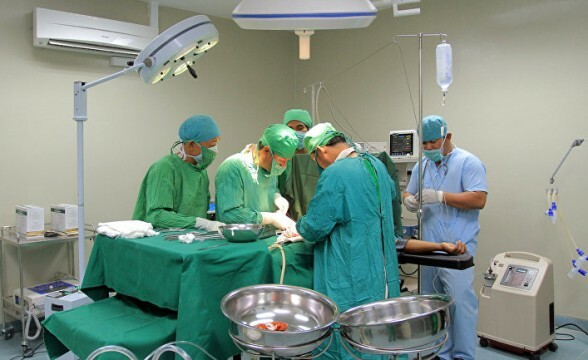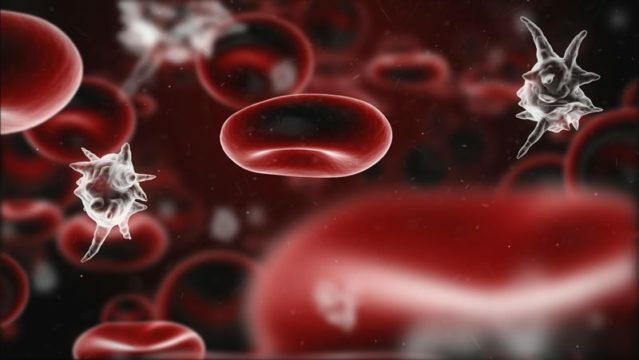Toxic diffuse goiter or Graves' disease is a polyethiologic disease that develops in persons who are predisposed to it, due to adverse heredity. It is accompanied by a diffuse increase in the size of the thyroid gland with an increase in the concentration of thyroid hormones in the blood. The disease is autoimmune, ie, it is accompanied by the aggression of the body against the thyroid gland.
Symptoms of toxic diffuse goiter

Symptoms of this disease affect almost all body systems, since the rate of metabolic reactions varies, the metabolism is accelerated at times. Explicit signs:
- persistent irritability;
- marked tremor of the extremities;
- increased heart rate;
- the most prominent symptom is pronounced exophthalmos;
This is one of the variants of thyrotoxicosis.
Treatment of diffuse toxic goiter is divided into three main areas, namely:
- drug therapy;
- surgical interventions;
- treatment with radioactive iodine, which is used with caution to treat this disease in adults.
Drug therapy
A group of drugs for the treatment of increased thyroid function is heterogeneous and includes drugs that affect different stages of thyroid hormone metabolism.
For treatment, drugs that inhibit the formation, secretion and conversion of T4 to T3 at the periphery, as well as drugs that inhibit their effect on the target organs, are needed.
Drugs that oppress the synthesis of thyroid-stimulating hormones
To drugs that inhibit the formation, secretion and peripheral conversion of T4 into T3 include derivatives of thiourea( thionamides, thyreostatics).The mechanism of their action is manifested in the interruption of the cycle of transformation of thyroid hormones. In addition, they have a moderate immunosuppressive effect, which is also important in the treatment because the disease is autoimmune.
The main drugs of this group are Mercazolil( Metimazol, Propitsil, Tyrozol). It should be emphasized that the preparation of this group propitsil. It has advantages in treating this disease in pregnant women and breast-feeding women because it is unable to penetrate into breast milk and through the placental barrier. In addition, the replacement for propitsil with the intolerance of Mercazolil.
The drugs of the thyreostatic group are able to depress hemopoiesis, which negatively affects the results of treatment of this thyroid disease. Therefore, it is necessary to monitor the general parameters of peripheral blood of the patient with a frequency not less than once a week.
Drugs that limit the action of thyroid hormones on target organs

Beta-blockers can be classified as this group of medicines. They are used exclusively with thionamide preparations and are unsuitable for monotherapy. This group of drugs well eliminates the symptoms of such a lesion of the gland, so they are used as symptomatic therapy. They do not influence hormone production in any way, they just block the beta receptors of target organs, which reduces the symptoms of ( tremor, palpitations, increased anxiety).
The main representative of this group of drugs is Obsidan. When you connect to the treatment of beta-blockers, the effect of thyrostatics-mediated treatment should not be evaluated by the pulse rate because beta-blockers reduce the heart rate.
Scheme of therapy for diffuse-toxic goiter
Treatment of diffuse toxic goiter is carried out in three stages:
- Parallel reception of thyreostatic drugs and preparations from the group of beta-blockers is prescribed( Obsidan).The duration of their joint admission is at least one and not more than two months. Dosage of thyreostatics is fifteen to twenty-five milligrams a day. Obsidan is dosed individually depending on the body weight of the patient one or two milligrams per kilogram per day and is taken in three doses. After two weeks, the result of the combined therapy is evaluated. A complex evaluation of the severity of symptoms of the lesion of the gland is carried out. With favorable results, an attempt is made to reduce the dose of the beta-blocker. If the symptom of tachycardia is returned again, then the previous dosage is returned and joint treatment continues for another month. Then they proceed to the next stage of treatment.
- Monotherapy with thyreostatics. The duration of this stage is two to three months. The dose of the drug does not change. Achieves a compensated state with a minimum of symptoms, i.e., a state of euthyroidism.
- The stage of remission. Correction of the remaining symptoms of defeat in the thyroid gland is performed. If the function of hormone production was inhibited by thyreostatics before the state of hypothyroidism, then the administration of L-thyroxine together with thyreostatics is prescribed. The dose of thyreostatics continues to decrease gradually, tending to a minimum( 7.5-2.5 mg / day once).At the minimum dose, the patient is three to four years old.
Surgical interventions
There are a number of indications to this method of treatment:
- This is the presence of allergic reactions in response to the use of thyreostatic drugs;
- if the size of the tibial formation reaches the fourth degree and more;
- if the reception of thyreostatics is accompanied by a persistent decrease in the level of leukocytes in the blood;
- if there is atrial fibrillation combined with symptoms of cardiovascular failure;
- pronounced zobogenous effect from the use of thyreostatic drugs.
- zagrudinnoe arrangement of goiter;
- toxic goiter in teenage girls 15 years and older. This indication is associated with the onset of reproductive age, and prolonged thyreostatic therapy is not acceptable.

Surgical correction of the size of the thyroid gland is performed in the stage of minimal manifestations of symptoms, i.e., in the stage of compensation.
Additional medicines in the postoperative period are appointed individually according to indications.
Types of surgical interventions
The operation to remove the thyroid gland is called thyroidectomy, but it is customary to isolate several of its subtypes.
- removal of the thyroid gland;
- removal of the proportion and isthmus between shares;
- removing part of one of the shares, more often this is the upper or lower pole;
- complete removal of the thyroid gland( rarely);
- removal of one thyroid gland completely + isthmus + removal of part of the second lobe.
The thyroid gland is difficult to perform surgery because it is difficult to track how much tissue must be removed to obtain the optimal result, so often after surgical interventions the state of hypothyroidism develops.
Postoperative complications
- During the operation, the laryngeal nerves are often damaged, which leads to paresis of the larynx.
- Near the thyroid gland are located other endocrine glands - parathyroid, some of which can be accidentally removed during surgery. Subsequently, this threatens the state of hypoparathyroidism because the surviving part of the parathyroid glands does not cope with the production of the necessary amount of hormones.
- It is also not uncommon to develop thyrotoxic crisis.
Preparing for operation
Before the surgery on the thyroid gland, to prevent further complications, short courses of special treatment are conducted. It can be:
- course of plasmapheresis or high doses of radioactive iodine( with thyroid intolerance) for eighty days before the operation;
- the appointment of thyreostatic drugs, as well as beta-blockers to eliminate tachycardia.

It should be remembered that 2-3 days before the appointed day, it is necessary to cancel preparations that can complicate the operation, increasing bleeding. These are:
- aspirin;
- cardiograph;
- Plavix;
- warfarin and other drugs that dilute blood.
If a patient is constantly taking medications for this group, he should report this to the treating doctor.
Before the operation, a full medical examination is performed with the necessary analyzes of blood, urine, scanning and ultrasound examination of the thyroid gland.
During the operation, the patient is under general anesthesia in a state of deep sleep. The duration of thyroidectomy depends on the volume of interventions performed and on average lasts two to four hours.
Indications and contraindications for treatment with radioactive iodine
This method of treatment is used only in adults, in pediatric practice it has not found its application.
This method of treatment is used for those patients who can not perform other treatment regimens. The patient should be intolerant of thyreostatic drugs, relapse of the disease, the volume of goiter is not more than sixty milliliters, impossibility of conducting surgical interventions.
Absolutely contraindicated such treatment:
- to pregnant women;
- for women breastfeeding their babies;
- age to 45 years;
- presence of ophthalmopathy of endocrine origin.
Relatively contraindicated treatment with radioactive iodine when:
- suspected of having malignancy( the presence of cold nodes);
- spreading goiter in the vaginal space;
- large volume of goiter( over sixty milliliters).
The approach to such patients is individual, the decision is made collectively.
The dose of radioactive iodine for each patient is assigned individually.
The treatment of toxic goiter with radioactive iodine

The meaning of the treatment is to reduce the hyperthyroidism of the thyroid with the help of radioactive iodine and thereby correct the symptoms of toxic goiter.
The patient takes radioactive iodine in the form of capsules or tablets. Iodine has a high affinity for the tissues of the thyroid gland, where it is transported by transport proteins. After delivery to the cells of the gland, iodine concentrates in its tissues, causing destruction of the thyroid gland. Damaged tissue is not restored, but replaced by a proliferating connective tissue that does not have functional activity.
Before the beginning of such therapy, the doctor abolished thyreostatic medications( Mercazolil for seven days, and propitsil for 14 days).Women directly on the day of taking the first dose of the drug is recommended to make a pregnancy test. When receiving positive results, the drug is withdrawn. Symptoms of thyrotoxicosis significantly regress to the end of the second or third week of radioactive iodine intake. At the end of the first course, the patient's condition is assessed and if the symptoms of the disease begin to progress again, a second course of treatment is prescribed.
Consequences of treatment with radioactive iodine
During treatment with preparations of radioactive iodine, most often try to achieve complete regression of thyroid hyperthyroidism by crushing its function. The functional ability of the gland to determine the level of hormones in the patient's blood is monitored. The concentration of thyroid-stimulating hormone( TSH) in the blood, as well as the T4 level, is important. The analysis for these hormones is repeated every three to four months for the entire first year after the completion of taking radioactive iodine preparations.
Hypothyroidism in this case is the ultimate goal that the physician seeks in prescribing such treatment. Upon reaching this goal, the patient is given lifelong hormone replacement therapy with L-thyroxine.
This allows to maintain the patient's quality of life at the proper level with minimal inconvenience.
Women of reproductive age are recommended a preventive course of taking oral contraceptives for the entire course of treatment with radioactive iodine in order to avoid pregnancy.
It is proved that such therapy is safe with respect to the development of cancer, successfully used in Russia and foreign countries.
Behavior after treatment
After treatment, it is necessary to carefully observe the rules of personal hygiene, be sure to brush your teeth because there could be contamination of the oral cavity with the drug. In connection with this, liquid isotopes of radioactive iodine are rarely used.
It is recommended to drink more liquids more often than usual and to visit the toilet more often "on a small one".Men are recommended to perform an act of urination while sitting.
After treatment, you should avoid sexual contact for three weeks. Spouses are recommended to sleep in different beds.
Clothing treated with radioactive iodine should be washed separately from other people's clothes.
It is also necessary to avoid contact with other people, especially with pregnant and lactating women, within nine days after taking the drug.
If such a patient needs medical care, then he must inform the medical staff that he has been treated with radioactive iodine.
Planning of pregnancy is not allowed earlier than one and a half to two years after the treatment, because at an earlier time the child will be at risk for developing thyrotoxicosis.



